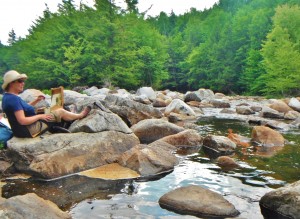Category Archives: Weekly Art Lessons 61-70
Aerial Perspective – The Atmosphere That Keeps You and Your Paintings Alive (Online art lesson # 61)
Air! You can’t live without it. It really is something, isn’t it? Take a deep breath: we are blessed to have such an atmosphere. Your paintings need this air to breathe too!
It is not empty space between you and the distant mountains. The Atmosphere in atmospheric / aerial perspective is a tangible thing.
Tips on seeing the atmosphere can be found at COLOR: Beware of Preconceptions (Online art lesson #35).… Read the rest
Between a Rock and a Wet Place: Keeping Your Art Balance (Online art lesson #62)
PleinAir Magazine’s Paint the Adirondacks Invitational – WOW!

Eric Rhoads and his team pulled off an event so inspirational that I will be motivated by it for months to come.
All the amazing people, paintings, and places… all the rare opportunities going on simultaneously… How does an artist – accustomed to working alone – stay balanced?
How do you sort yourself out in a situation so stimulating? … Read the rest
Drawing Flowers: The Individuals in the Bouquet (Online art lesson #63)
To honor the memory of Margaret Munt (July 3, 1954 – May 31, 2012), we’re drawing flowers this week.
- Select a few flowers almost at random. They can be wildflowers, roadside “weeds”, or carefully cultivated varieties.
- Admire each one from different viewpoints – above, below, front, and back.
- Think about the process of the buds opening and blooming. Note the different stages if they are showing in your flowers.
Must Have Art Books! (Online art lesson #64)
“Must have art books!” is a simple statement along the lines of “Will work for food!”
Rummaging through stacks of old books and papers, I felt like an addict needing a fix. I was tippy and needed an art book to provide ballast and stability. I need Old Masters in order to re-affirm that, yes, beauty and harmony can be created from chaos.… Read the rest
Linear Perspective: Cast Shadows (Online art lesson #65)
Hold your finger up and look at it. The side away from the light is darker. That is a FORM shadow. Now put your finger on a piece of white paper. The paper is darker next to the dark side of your finger. That is a CAST shadow. They are handled differently in painting.
For example, it is great to see a form shadow on a person’s nose, but if you’ve ever looked at photos or paintings with harsh shadows cast by that nose on a cheek, you’ll know that the cast shadow, in this case, breaks up the form of the face.… Read the rest
